In a digital marketing world rocked by SEO upheavals and the relentless pace of search engine algorithm updates, influencer marketing not only persists—it thrives. Amidst this resilience, the industry faces new uncertainties with potential TikTok bans and Meta’s stringent API changes, adding layers of complexity to platform reliance and data accessibility.
Our latest survey of 237 marketing professionals reveals a landscape where 66.8% are planning to increase their influencer marketing budgets in the coming year, signaling a robust confidence not seen in other sectors. This contrasts sharply with the general anxiety surrounding more traditional digital marketing tactics, such as SEO, which constantly grapple with Google’s algorithm changes.
Despite its rising popularity, influencer marketing is not without its challenges either. A significant 44% of marketers pinpoint identifying the right influencers as their top hurdle in our survey conducted in May 2024, reflecting the nuanced nature of this personal and impactful marketing approach. Moreover, while 32% find influencer marketing not effective, a compelling 24.6% deem it very effective, highlighting a polarized experience that demands a deeper dive.
Our May 2024 Influencer Benchmark Report delves into these dynamics, offering a clear, structured analysis packed with actionable insights. In this report, we decode the current sentiment amongst marketers in relation to Influencer Marketing, 100% based on unique first-party data findings, via our pool of leading marketers.
Summary:
The Short Version – Quick Facts
- Dominant Platforms: Instagram (39.2%) and TikTok (38%) are neck-and-neck as the top platforms for influencer marketing campaigns, showcasing the ongoing preference for visually driven social media.
- Rising Influence of Nano Influencers: Nano influencers (53.8%) dominate brand collaborations, suggesting a shift towards authenticity and niche audiences over broader reach.
- Investment Levels: 26.1% allocate less than 10% of their marketing budget to influencer marketing, indicating room for growth in this area.
- Effectiveness Perception: 24.6% of marketers find influencer marketing very effective, highlighting its significant impact on marketing strategies.
- Budget Trends: A substantial 66.2% of marketers plan to increase their influencer marketing budget next year, reflecting confidence in this marketing method.
- Content Formats: Video posts (57.4%) are considered the most effective content format in influencer campaigns, underscoring the importance of dynamic and engaging content.
- Technology Adoption: A large segment of marketers (42.5%) do not use any technology or tools to manage influencer campaigns, pointing to potential growth in the influencer tech sector.
- Top Challenges: Identifying the right influencers is the biggest challenge faced (44%), stressing the need for better discovery tools and methods.
- ROI Measurement: Engagement rates (55.9%) remain the primary metric for measuring the success of influencer campaigns, with conversion rates (19.9%) also playing a crucial role.
- Algorithm Impact: A significant majority (81.1%) have adjusted their influencer marketing strategies due to platform algorithm updates, indicating high responsiveness to digital environment changes.
- Incentive Strategies: Free products are the most common form of influencer incentive (56.2%), but monetary compensation is also widely used (20.1%).
- Campaign Frequency: Most brands (59.4%) launch influencer marketing campaigns monthly, highlighting the tactic’s role as a regular marketing activity.
- Integration with Marketing: A vast majority of respondents (89%) believe that influencer marketing integrates well with their other marketing efforts, illustrating its effectiveness as part of a comprehensive strategy.
- Emerging Trends: The growth of video content (44.6%) and the increased use of AI for influencer discovery and management (36%) are seen as the most impactful trends for the next year.
- Focus on Direct Sales: Over half of the marketers (54.9%) aim their influencer marketing efforts at direct sales more than at brand awareness, emphasizing its effectiveness in driving immediate business outcomes.
Platform Preferences in Influencer Marketing
The landscape of influencer marketing platforms remains highly competitive and diverse. According to our survey:
- Instagram remains a staple for influencer campaigns, utilized by 39.2% of respondents.
- TikTok closely follows with 38%, reflecting its rapid ascent as a powerhouse for engaging content.
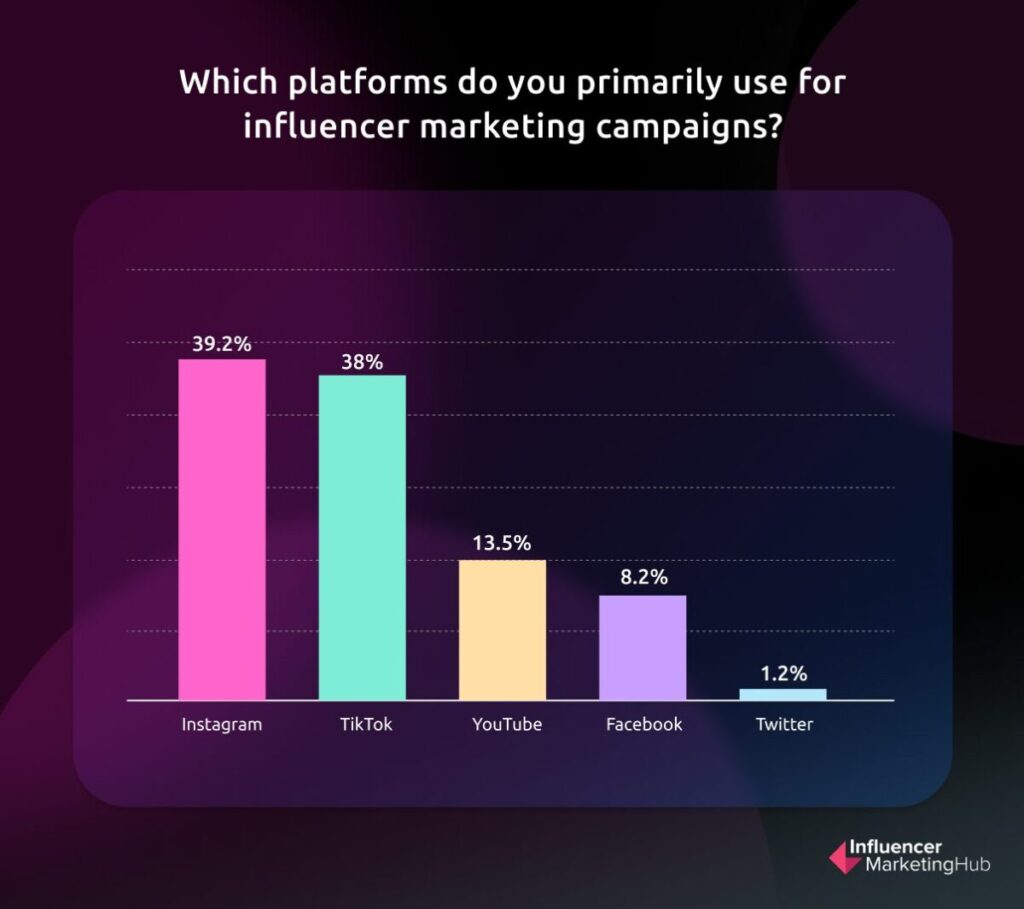
- YouTube and Facebook continue to play significant roles, preferred by 13.5% and 8.2% of marketers, respectively.
- This data suggests a strategic diversification in platform use, ensuring brands can engage audiences across multiple touchpoints.
Last year’s data from our annual Influencer Marketing Benchmark Report, which asked respondents “Which channels do you predominantly tap into for influencer marketing campaigns?” indicated a much higher preference for TikTok, with 67.8% of brands leveraging it for their campaigns. This contrasts with this year’s survey phrasing, “Which platforms do you primarily use for influencer marketing campaigns?” where only 38% of respondents indicated TikTok as their choice.
The significant drop in preference for TikTok this year may be influenced not only by the differences in how the question was framed but also by the looming uncertainty surrounding the potential TikTok ban, which could be causing marketers to reconsider their platform strategies amidst evolving regulatory concerns.
Budget Allocation Across Influencer Tiers
Marketers show a clear preference for more accessible influencers, indicating a shift towards authenticity:
- Nano influencers (1K–10K followers) are primarily engaged by 53.8% of brands, underscoring their cost-effectiveness and high engagement rates.
- Micro influencers follow, engaged by 21.6% of respondents, balancing reach and relatability.
- Macro and mega influencers are utilized less frequently, highlighting a strategic focus on influencers who resonate more genuinely with niche audiences.

Last year in our yearly Influencer Benchmark Survey, 44% of brands chose nano influencers as their most likely partners, marking an increase to this year’s 53.8%. This growth suggests an intensified appreciation for the high engagement and authenticity that nano influencers can offer. Preference for micro-influencers has slightly decreased from last year’s 25.7% to 21.6% this year. This shift might reflect a strategic reallocation towards even smaller influencers or a broader diversification in influencer marketing tactics.
The May 2024 influencer marketing data corroborates a continuing trend towards leveraging nano and micro-influencers, driven by their ability to engage more effectively with specific audience segments.
Effectiveness and Budgeting Trends in Influencer Marketing
Despite varying opinions on effectiveness, the commitment to influencer marketing remains strong:
- 66.2% of marketers plan to increase their influencer marketing budgets, signaling strong faith in its ROI.
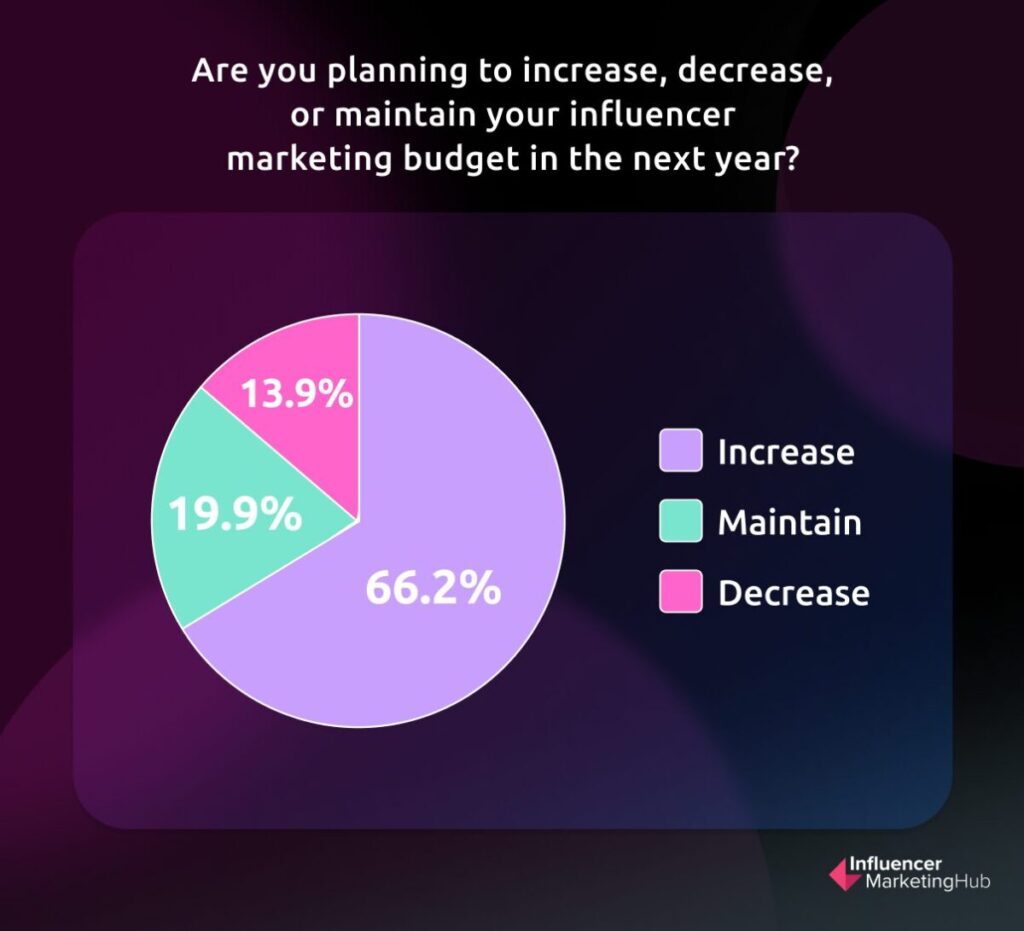
- 24.6% of respondents find influencer marketing very effective, while only 7.4% deem it extremely effective, suggesting room for optimization in campaign strategies.
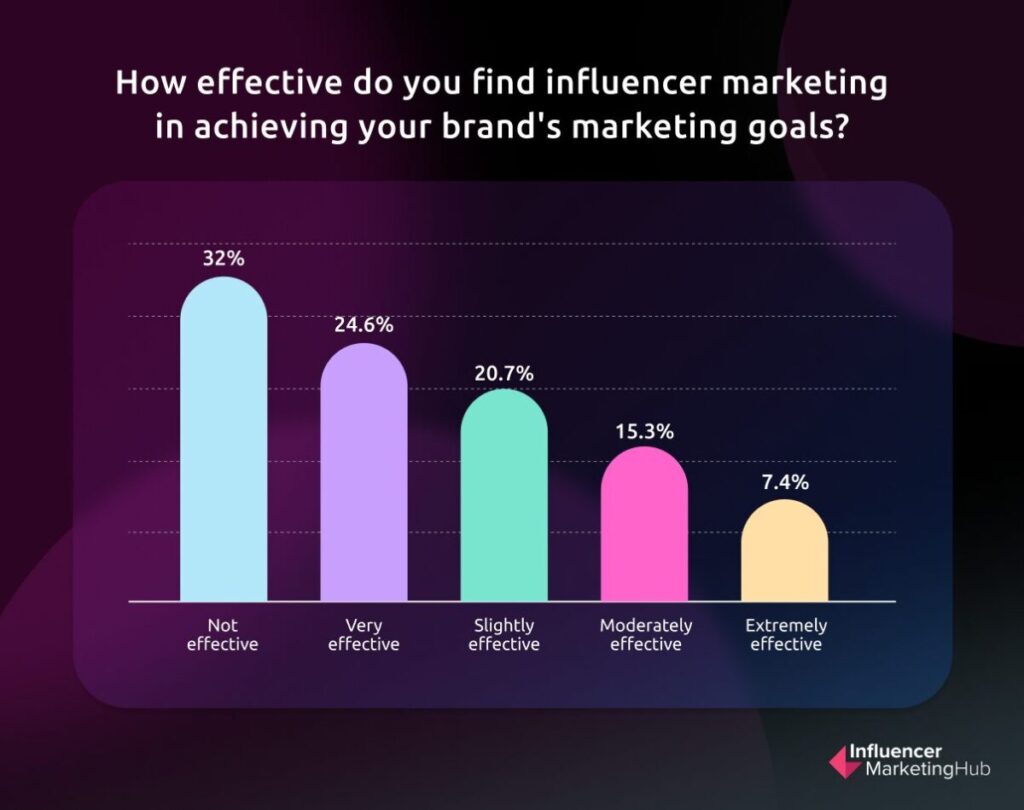
Year-over-Year Comparison:
- Budget Increases: The commitment to enhance influencer marketing budgets has shown a slight uptick from last year’s 59.4%. This consistent increase underscores the growing recognition of the value delivered by influencer marketing strategies.
- Budget Allocation: This year, 26.1% of respondents expect to spend less than 10% of their marketing budget on influencer marketing, up from last year’s 20%. Meanwhile, 24.2% of brands are dedicated fans of influencer marketing, planning to spend more than 40% of their marketing budget on such campaigns. This is a considerable rise from 23% in 2023, showcasing a deepening trust in the effectiveness of influencer marketing.
- Decrease in Budgets: The percentage of marketers planning to decrease their influencer marketing budget is marginally higher this year at 13.9%, compared to last year’s 7%. This might reflect a more cautious approach amidst economic uncertainties, even as the overall sector sees an upward trend in investment.
Strategic Implications:
These trends not only reflect the resilience of influencer marketing as an effective strategy but also highlight how brands are progressively adapting their budgets to leverage its benefits. The increase in marketers spending a significant portion of their budget on influencer marketing emphasizes its central role in contemporary digital strategies. However, the slight increase in those reducing their budgets could signal a need for more demonstrable ROI to sustain or increase investment levels in the future.
Challenges in Influencer Marketing
Identifying the right influencer remains the most significant challenge, cited by 44% of marketers. Other notable challenges include:
- Contract management and negotiation difficulties (17.1%),
- ROI measurement complexities (15.5%), and concerns over influencer fraud and brand alignment (11.9% and 11.4%, respectively).
- These challenges highlight critical areas where businesses seek improvements, from better selection processes to more transparent and effective collaboration terms.

In light of the recent upheaval caused by Meta’s restrictions on third-party data, the influencer marketing industry faces a pivotal shift toward first-party data reliance. This transition, exemplified by Grin’s rapid adaptation in compliance with Meta’s API changes, underscores a broader industry challenge: the pressing need for platforms to secure robust, consent-based data channels.
As platforms scramble to adjust, the implications for influencer marketing are profound. Businesses must navigate these changes wisely to maintain efficacy, particularly as 44% of marketers already struggle with identifying the right influencers—a task complicated further by restricted access to reliable data. This evolving landscape calls for a strategic pivot to first-party data, ensuring that influencer marketing remains a powerful, effective tool despite the challenges highlighted by the industry’s mixed effectiveness ratings.
Most Effective Content Types and Campaign Frequency
Video content emerges as the most effective, with 57.4% of marketers favoring it over images, stories, and live sessions. This preference aligns with the rise of platforms like TikTok and the ongoing popularity of YouTube. Regarding campaign launches:
-
The majority (59.4%) launch campaigns monthly, demonstrating the dynamic and ongoing nature of influencer engagements in marketing strategies.

Integration and Perception of Effectiveness
A significant majority of respondents (89%) believe that influencer marketing integrates well with their other marketing efforts, reinforcing its value as a complementary strategy.
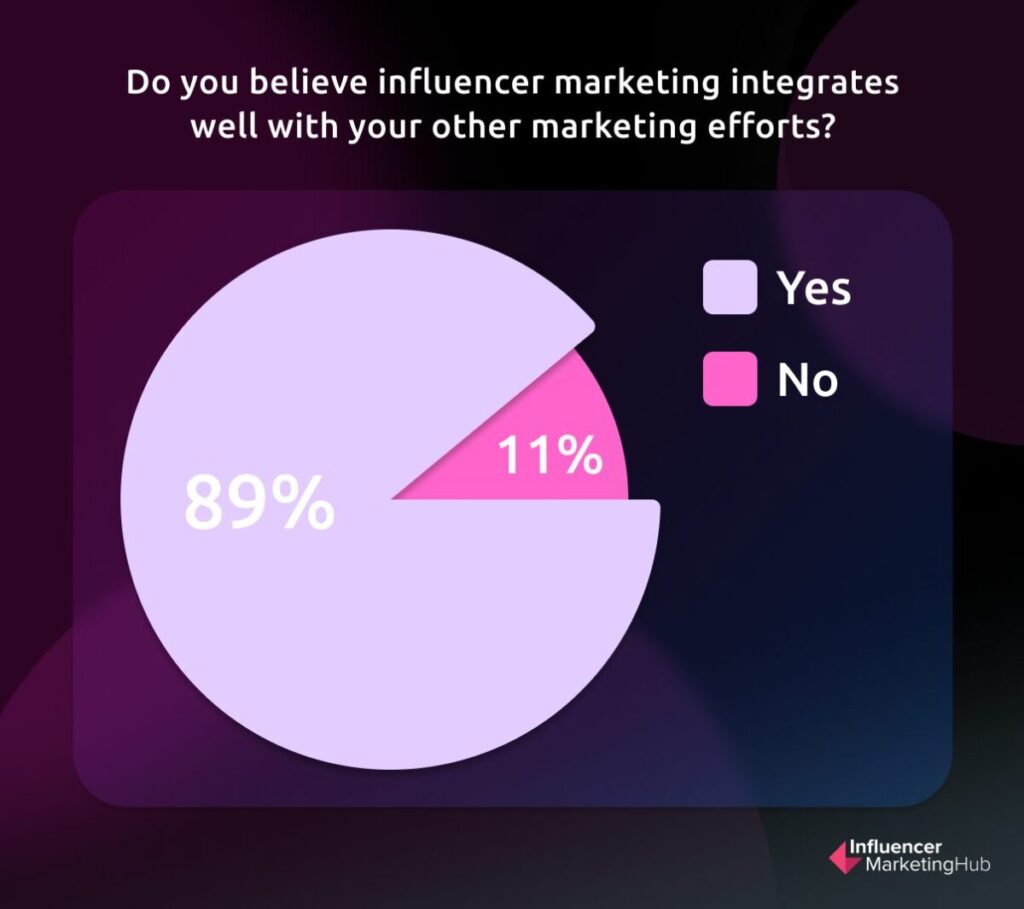
In terms of effectiveness:
- 24.6% find it very effective, indicating a strong impact on marketing goals.
- Despite some skepticism, with 32% considering it not effective, the overall sentiment remains positive, as 85% of businesses continue to dedicate a budget to influencer marketing, up from previous years.
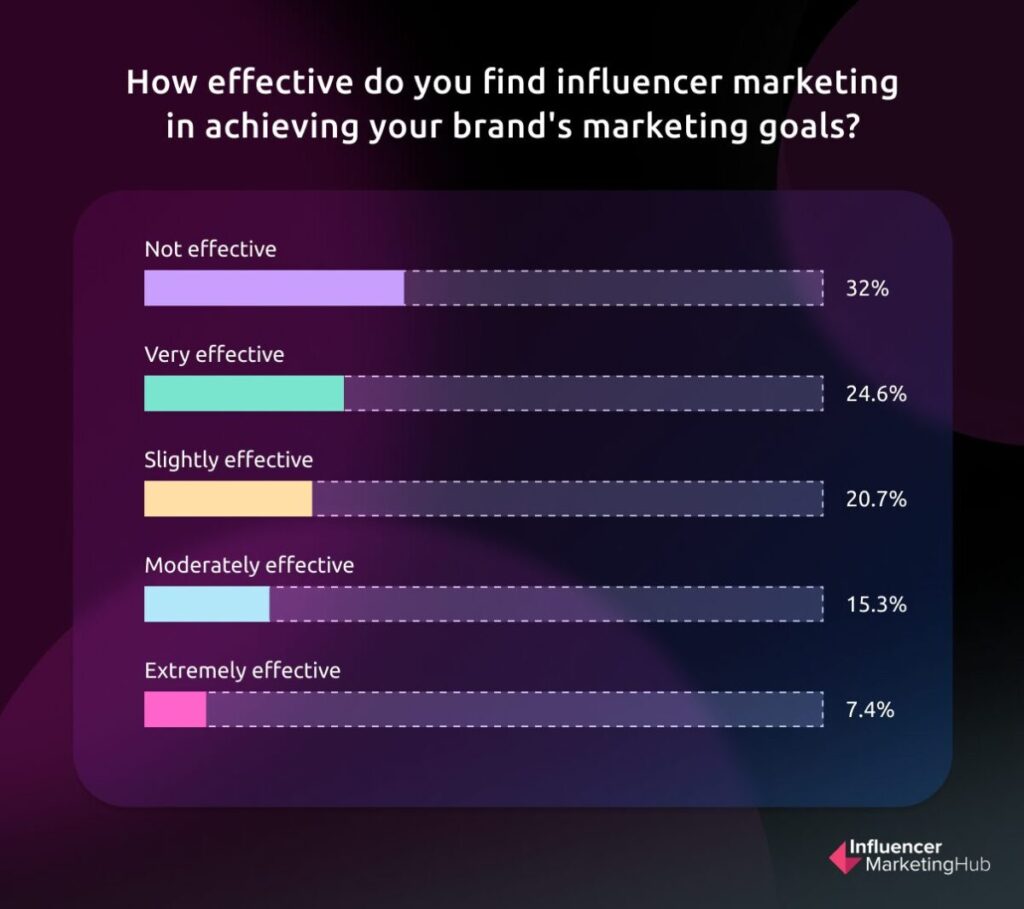
Adaptation to Platform Changes
The dynamic nature of social platforms requires marketers to remain adaptable. A substantial 81.1% of marketers have changed their approach to influencer marketing due to recent platform algorithm updates, demonstrating a proactive stance in maintaining campaign effectiveness across varying digital environments.
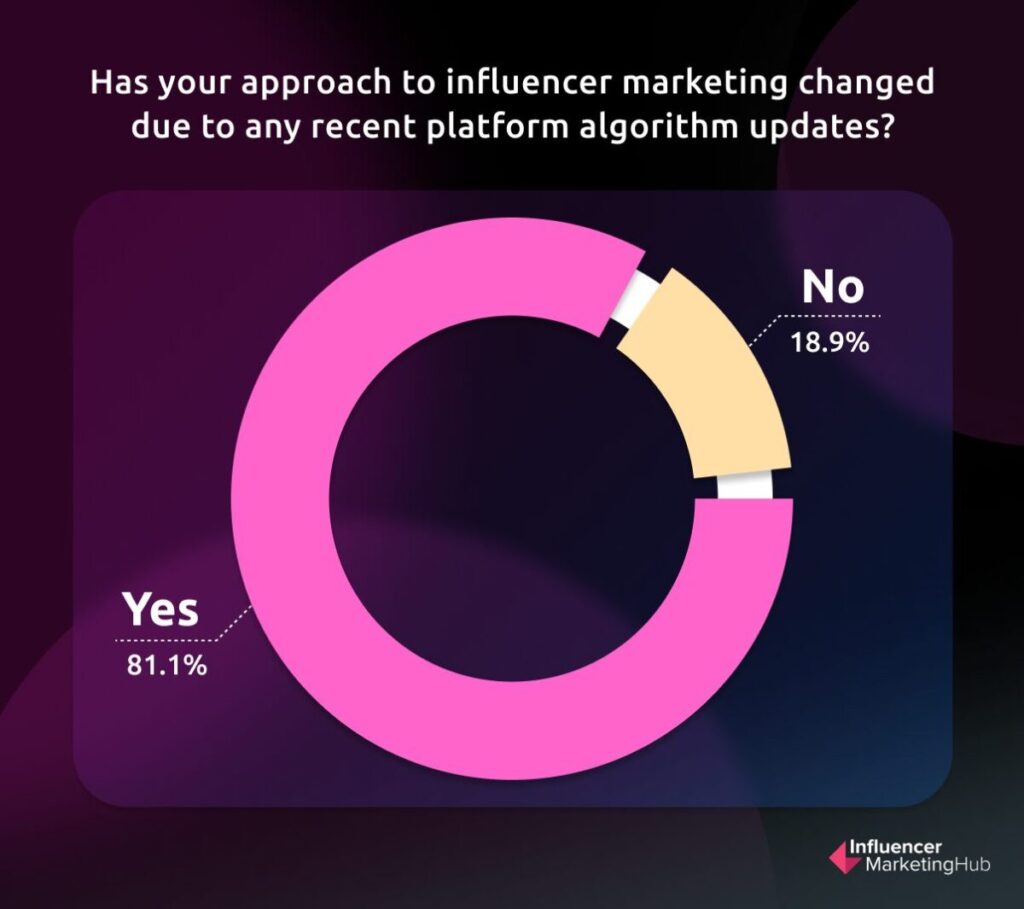
Incentives Used in Influencer Campaigns
Incentives play a crucial role in the execution of influencer campaigns. The survey reveals:
- Free products are the most common incentive, used by 56.2% of brands.
- Monetary compensation follows at 20.1%, highlighting the professional nature of these partnerships.
- Smaller incentives like discounts and coupons (12.4%) and commissions based on sales (11.3%) are also utilized to diversify engagement strategies.
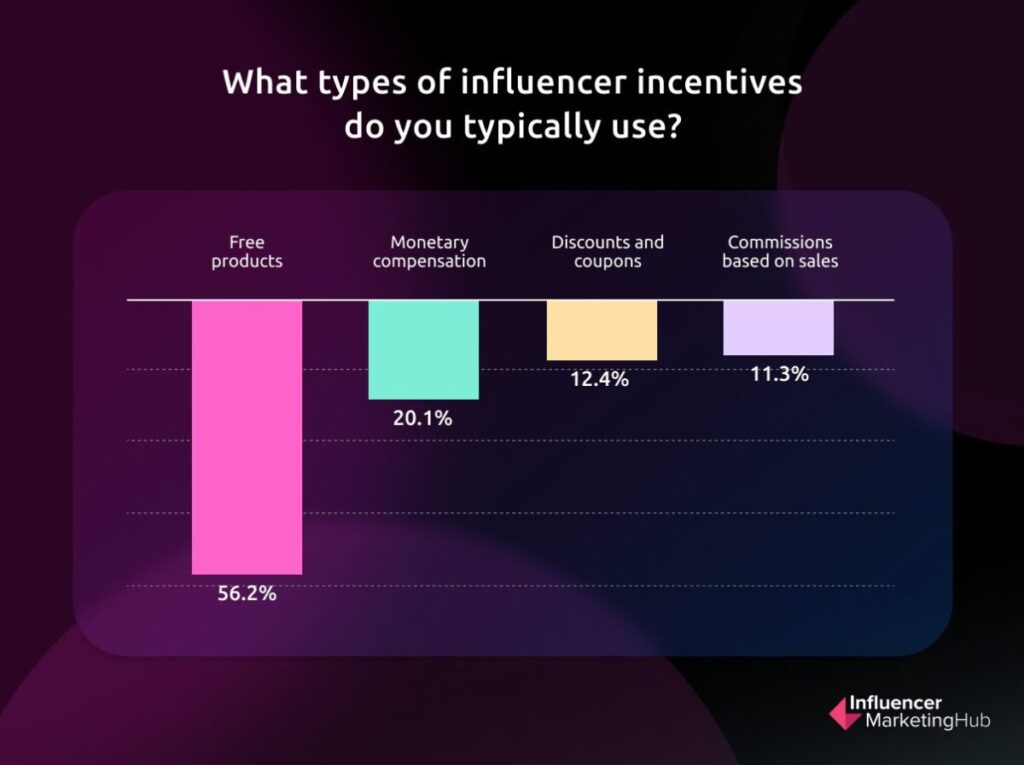
Objectives of Campaigns
Influencer marketing is not a sporadic activity but a regular part of the marketing mix:
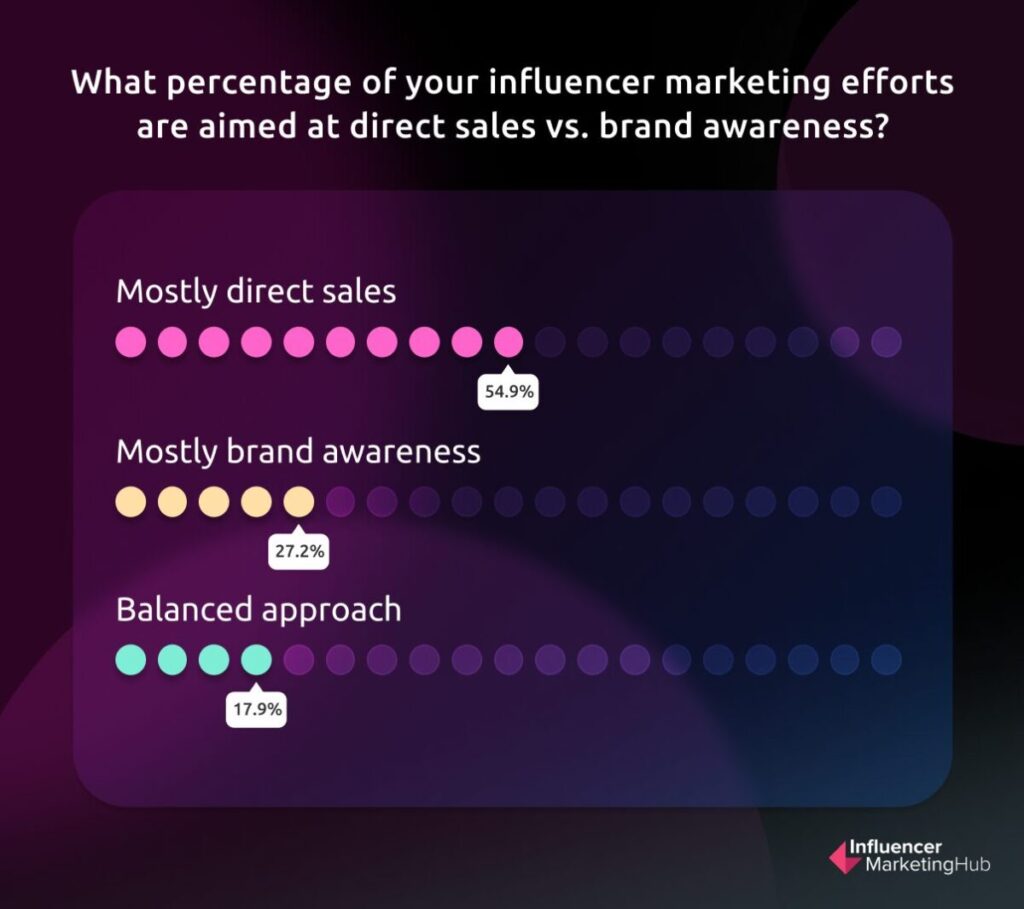
Emerging Trends and Future Focus
Looking ahead, marketers are identifying key trends that will shape the future of influencer marketing:
- Growth of video content is anticipated to be the most impactful trend, noted by 44.6% of respondents.
- The use of AI for influencer discovery and management is also expected to rise, with 36% seeing it as a significant future trend.
- There is a notable focus on micro and nano influencers, which is expected to enhance the authenticity and effectiveness of campaigns.
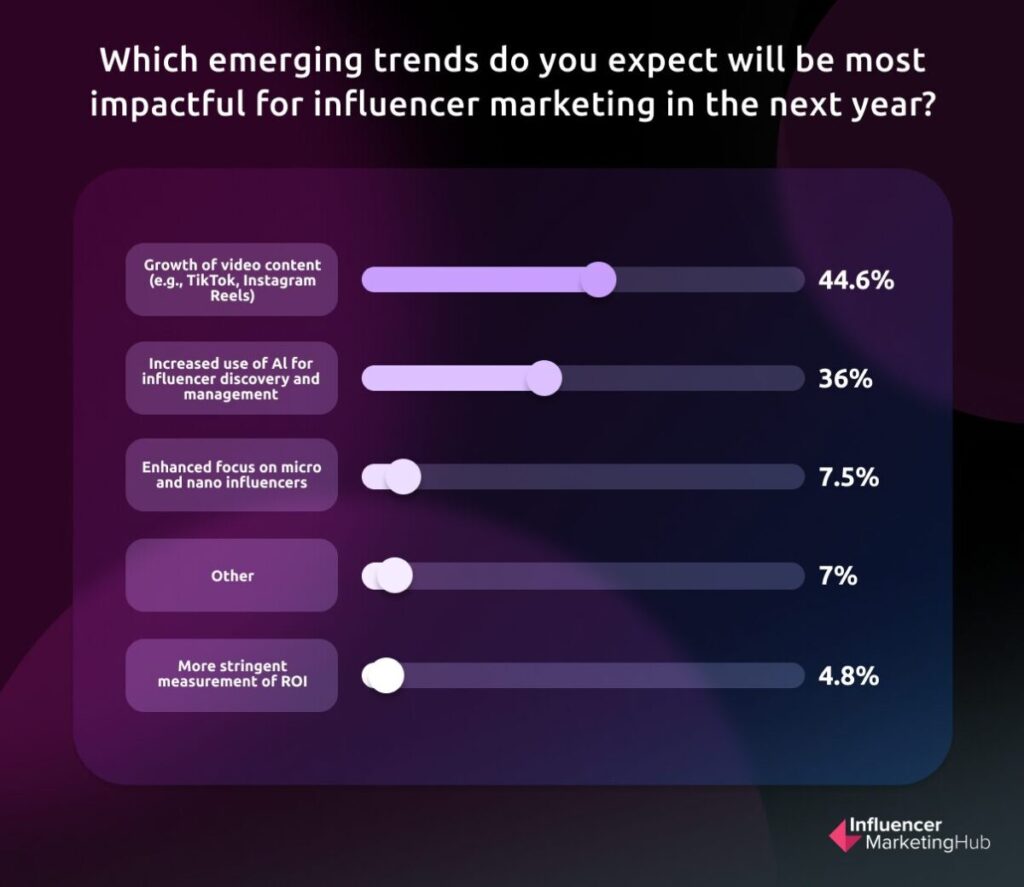
Deep Dive into AI Utilization in Influencer Marketing from Last years AI Influencer Marketing Benchmark Report:
- Adoption of AI Technologies: 61.4% of marketers have already integrated AI into their marketing activities, with 44.4% utilizing AI specifically for content production. Tools like Jasper.ai are particularly popular, used by 32.8% of marketers, demonstrating AI’s role in streamlining content creation.
- Optimism About AI’s Potential: A substantial 54.5% of marketers believe AI will greatly enhance their marketing efforts. Moreover, 71.2% contend that AI can outperform humans in certain job functions, underscoring the expected shift towards more AI-driven operations within influencer marketing.
- Investment in AI-Driven Campaigns: Reflecting a commitment to leveraging AI, 19.2% of respondents spent more than 40% of their marketing budget on AI-driven campaigns. This significant investment highlights the growing reliance on AI to deliver tailored and impactful marketing strategies.
- Future Projections: More than 60% of marketers plan to use AI or machine learning in their influencer campaigns. However, challenges remain, as 41.9% have not adopted AI due to a lack of understanding, and 23.7% are deterred by the high cost of implementation.
- Human-AI Collaboration: As AI takes on more operational tasks in marketing, 42.2% of professionals believe that high-level strategy and decision-making will remain in the hands of human marketers. This delineates a future where AI enhances capabilities without replacing the essential creative and strategic input of human expertise.
Conclusion: Navigating the Future of Influencer Marketing
As we reflect on the findings from our comprehensive survey of 237 marketing professionals, it’s evident that influencer marketing is not just surviving; it’s thriving and evolving in a complex digital landscape. With a projected market size of $24 billion by 2024, influencer marketing is poised for unprecedented growth, signaling its increasing importance in the broader marketing ecosystem.
Key Takeaways
- Platform Diversity and Adaptability: The close competition between Instagram and TikTok, along with the steady use of YouTube and Facebook, underscores the need for brands to maintain a flexible and platform-diverse strategy that adapts to changing consumer behaviors and algorithm updates.
- Strategic Investment: Despite economic uncertainties, the significant intent to increase budgets for influencer marketing highlights the confidence businesses have in this strategy. This investment is not just a testament to its current effectiveness but also an investment in leveraging future trends such as video content and AI-driven tools.
- Challenges and Opportunities: Identifying the right influencers and measuring the ROI of campaigns remain the most significant challenges. These obstacles present opportunities for innovation in measurement tools and discovery platforms, which could drive the next wave of efficiency and effectiveness in influencer campaigns.
Looking Ahead
As the digital marketing realm continues to evolve, the role of influencer marketing becomes increasingly critical. The movement towards more authentic engagements through nano and micro influencers, coupled with the rising importance of video content, suggests a shift towards more personalized and impactful marketing approaches. Marketers are encouraged to not only keep pace with these trends but to anticipate them, integrating advanced analytics and AI to refine strategies and enhance outcomes.
Call to Action
In an era where digital noise is louder than ever, the clarity provided by effective influencer marketing can make the difference between a brand that is merely visible and one that truly resonates with its audience. Marketers are advised to:
- Embrace Technological Advancements: Leverage emerging AI tools for better influencer identification and campaign management.
- Focus on Authenticity: Invest in relationships with nano and micro influencers to enhance trust and engagement with target audiences.
- Enhance Measurement Techniques: Develop more sophisticated metrics that go beyond likes and shares to measure true ROI and impact.
Final Thoughts
Let this report be not just a reflection of where influencer marketing stands today, but also a beacon for strategic direction. As you plan your future campaigns, consider how you can turn these insights into action. The future of influencer marketing is bright, and by embracing these evolving trends, your brand can illuminate its path to success in the dynamic marketplace of tomorrow.
Methodology and Data Transparency
To ensure the highest degree of reliability and transparency, this Influencer Marketing Benchmark Report is based on a meticulously conducted survey involving 2373 marketing professionals. These participants were sourced across diverse sectors, ensuring a broad representation of the industry.
Survey Execution:
The survey was hosted and administered via influencermarketinghub.com, targeted specifically at pages related to influencer marketing topics to reach the most relevant audience. This method ensured that the respondents were professionals actively engaged with or interested in influencer marketing strategies, providing insights that are both relevant and actionable.
Data Collection and Accessibility:
We utilized a comprehensive online survey platform that allowed for detailed question structuring and response analysis. The survey included a variety of question types, such as multiple choice, scale rating, and open-ended responses, to gather nuanced data on influencer marketing practices, challenges, and trends.
Transparency and Access to Data:
In commitment to transparency and to foster trust with our readers, the complete dataset from the survey is available for review. This dataset includes all responses, anonymized to protect the privacy of the participants, along with the methodologies used for data collection and analysis. Access to this dataset allows interested parties to perform their own analysis and verify findings presented in this report.
Proof of Methodology:
We ensure that all survey practices adhere to high standards of research integrity and ethical guidelines. The survey was designed to avoid leading questions, minimize bias, and provide respondents with the freedom to express their true opinions and experiences in influencer marketing.
Continued Engagement and Updates:
This report is part of an ongoing series that tracks trends and changes in influencer marketing annually. We continuously refine our methodology based on feedback and evolving research standards to enhance the accuracy and relevance of the information we provide.
By sharing our methodology and data, we aim to contribute to the growing body of knowledge in influencer marketing and support marketers in making informed decisions that drive success in their campaigns.













Leave a Reply